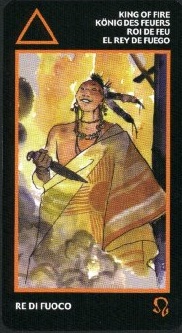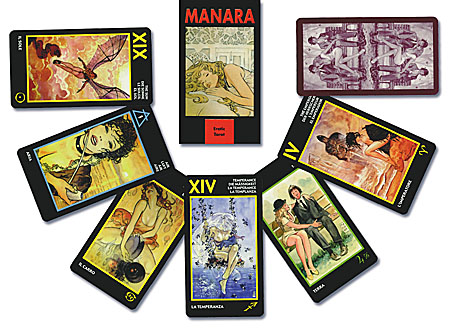|
Tarot Reflections |
|
July 01, 2003 |
|
Deck Review:
Manara Erotic Tarot Christopher delaMaison, CPTR |
||||||
|
Originally, I picked this deck up to compare it to the Casanova deck, also from Lo Scarabeo, that I had purchased much earlier. After looking through this deck, I find that it isn’t a comparable deck to the Casanova at all, but a wholly different deck, with it’s own feel and purpose. The Manara deck is published by Lo Scarabeo in Italy, and is imported by Llewellyn Worldwide. The artwork used in the deck is from an Italian artist and writer Milo Manara. Manara specializes in erotic comic books and paperbacks, which feature a number of female characters that are placed in various situations spanning the full range of sexual situations. Several of the pictures used in this deck are his more well-known works, such as the Ace of Air, which is the cover girl on his paperback El Gaucho. My first Lo Scarabeo deck was the Universal deck, which I use as my main “working” deck. I have always been very pleased with Lo Scarabeo decks, as they all seem to come with a small booklet, giving the new reader a few quick hints, as well as some background into the deck, as well as general tarot reading tips. Like the Casanova deck, the Manara deck has Justice as the Eighth and Strength as the Eleventh Major Arcanas. As my original tarot training was in the Masonic lodge, I am use to seeing these cards in their transposed positions, as presented in the Rider-Waite-Smith deck. For most seasoned readers, this transposition is usually not a problem. Another interesting difference with the Manara deck is his substitution of the alchemical symbols of Fire for Wands, Water for Cups, Air for Swords, and Earth for Pentacles. Manara uses this vehicle to keep the deck aligned with these four elements, but is still able to divest himself of the standard symbols for these tarot suits. This allows the artist the freedom to use artwork for a particular card that may not have the standard tarot symbols included. The problem with jettisoning the standard tarot symbols is that these symbols form the currency with which we exchange our impressions and insights of our readings with our clients. The standard tarot symbols are items deeply imbedded within our culture and psyche. They cannot be simply done away with for artistic license.
|
|||||
|
Now, while I am no expert on erotic art, I have to say that some of the cards are intriguing, some are a bit disturbing, and some simply fall flat. A good example can be seen by comparing the four Ace cards of the deck. The Ace of Earth shows a young woman with light brown hair and a dark green wreath. Although there is no sign of anything that would suggest a pentacle, this picture comes across as being very grounding and earthy. The Ace of Air shows a woman holding a long stem pipe. I could see the Air-Smoke connection here, but then again an argument could be made for a Smoke-Fire connection as well. The Ace of Water shows a woman in a red British military coat, with a ship in the background. Again, the red coat would lead me to think of a fire connection here, rather than a water connection. The Ace of Fire shows a woman eating what looks like a chocolate heart. This brings to mind a heart-cups connection, rather than a fire connection.
Another Major Arcana that seems to be a bit disturbing is the Justice card. This card shows a woman peeking out from behind a carved wood screen. She isn’t carrying a set of scales or a sword, she is just peeking out from behind a screen. To me, this isn’t the Lady of Justice. This character seems to be more timid and frightened than ready to weigh the truth of matters brought before her, and deal out justice. Justice, as a concept or universal equalization, must be able to stand out in the light, not peek around corners. One court card that does stand out as being representative of its suit is the Knave of Air. This card shows a worker dancing to the tune he is hearing through his headphones. Holding a wrench and dressed in greasy, dirty overalls, he is light on his feet, dancing around what looks like a jet of escaping steam; perhaps the problem he is suppose to be working on. This card seems to be very light and airy, matching the lady in the Ace of Air. Many of the cards have a more playful character. They show young women teasing men, and being very self-confident and assertive. This adds to the attractiveness of the deck in general. For myself, I would be less inclined to use this deck in any serious divination for my clients. I would, however, be tempted to bring this deck out at a party, where the participants were consenting, mature adults exploring their sexual desires and inhibitions.
Published by Lo Scarabeo, Torino, Italy. Available in the U.S. from Llewellyn Worldwide, Ltd. ISBN 0-73870-022-3.
|
||||||
|
Subscribe to Tarot Reflections, and receive notification of each update! |
|
Request to be added to the list by sending email to TarotReflections-subscribe@yahoogroups.com! |
All articles remain the
property of their respective authors.
Tarot Reflections is a publication of the American Tarot Association
- Copyright (C) 2003
Questions or Comments? Contact Us.



